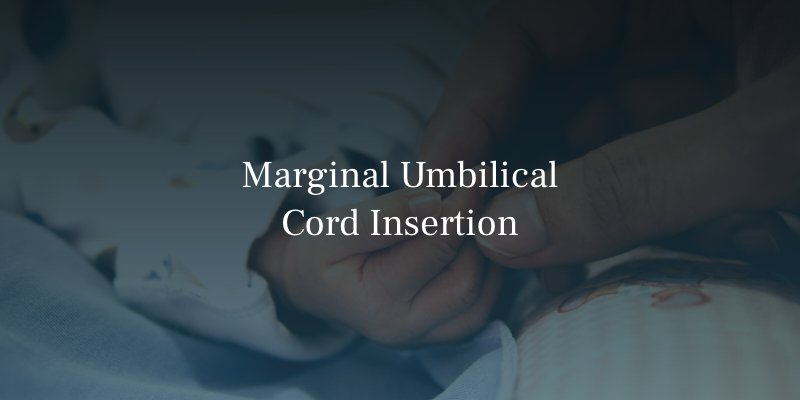Marginal cord insertion is one of those lesser-known terms that might make you raise an eyebrow. But understanding it is important, especially if you or a family member is pregnant.
One end of the umbilical cord attaches to a baby’s belly button. The other end attaches to the placenta. But did you know that it can’t just attach to any place on the placenta?
It should be stuck straight in the middle, a “bullseye” if you will. When it attaches to one side, it’s called a marginal umbilical cord. That’s abnormal, and it carries certain risks.
In this post, we’ll break it down and explore the marginal cord insertion risks and complications, as well as how it’s diagnosed and treated.
We’ll even tackle the tricky question: Can you file a malpractice claim for failure to treat marginal cord insertion?

What is Marginal Cord Insertion?
The umbilical cord is the lifeline between a baby and its mom during pregnancy. Blood and nutrients pass through it constantly.
In a normal pregnancy, the umbilical cord attaches to the center of the placenta, like a perfectly placed bullseye. But in the case of marginal cord insertion, the umbilical cord attaches off to the side of the placenta. It’s like missing the target by a hair.
Why does it matter if the cord doesn’t attach exactly in the center? Well, the umbilical cord is the baby’s lifeline, delivering nutrients and oxygen. So its placement matters.
According to the Cleveland Clinic, marginal cord insertion happens in between 2% and 25% of pregnancies. It’s a wide range because single births are on the lower end, and multiples are on the higher end.
There are other types of abnormal cord insertions, and this type is one of the least dangerous. It’s only a problem when it affects the baby’s food and oxygen supply. It can affect how the baby grows. At the very least, it’s something for doctors to keep an eye on.
What Causes Marginal Umbilical Cord Insertion?
Research hasn’t revealed why marginal umbilical cords happen, at least not yet. There aren’t any genetic factors linked to it. However, there do seem to be certain risk factors.
Who Is Most at Risk for Marginal Cord Insertion?
Marginal cord insertion could happen to anyone. But research suggests that certain factors can make it more likely, including:
- Carrying twins or multiples
- Being over age 35
- Having previous pregnancies, especially with complications
- Having underlying health conditions like diabetes or high blood pressure
That being said, just because you fall into one of these categories doesn’t mean you’ll definitely experience the condition. It’s just one of those things that sometimes happens for no clear reason. Like when you miss the bullseye, despite the weather being perfect and having practiced for hours.
Marginal Cord Insertion Risks
Many pregnancies with marginal cord insertion go on to be perfectly healthy. But there are some risks to be aware of, such as:
IUGR
Since the umbilical cord isn’t in its usual spot, the placenta might not get all the blood it needs.
This could lead to intrauterine growth restriction (IUGR), a condition where the baby doesn’t grow as expected. IUGR can cause low birth weight. A baby born like this could need extra care after delivery.
Preterm Birth
Another potential risk is preterm birth. The abnormal cord placement could cause the baby to arrive earlier than planned. That can sometimes bring its own set of challenges, especially if the baby’s lungs aren’t fully developed.
Placental Abruption
One of the more serious marginal cord insertion risks involves the placenta itself. In some cases, the placenta could separate from the wall of the uterus too early. That’s called placental abruption. It’s very dangerous for both the mother and the baby. There could be a lot of blood loss, so doctors must act fast to deliver the baby and treat the mother.
Marginal Cord Complications
Beyond the risks, serious marginal cord insertion complications can pop up. But these aren’t very common.
One possible complication is a vasa previa, where blood vessels from the umbilical cord cross the cervix. This can cause serious bleeding during delivery if not detected early.
Normally, these blood vessels are protected within the umbilical cord and placenta. However, in vasa previa, these vessels aren’t protected. They’re at risk of being compressed or ruptured if the cervix starts to open before delivery. This can cause severe bleeding for the baby and can be life-threatening if doctors fail to detect and treat it.
Another condition to be aware of is velamentous cord insertion, which has an increased risk profile compared to marginal cord insertion and can lead to severe outcomes like vasa previa and intrauterine growth restrictions.
Additionally, umbilical cord compression can occur, where the cord gets squeezed because it’s in a more vulnerable position. It can lead to reduced blood flow to the baby, affecting their heart rate and oxygen levels during labor.
While these complications sound scary, know that most cases of marginal cord insertion can be managed and won’t lead to complications. Getting regular check-ups during pregnancy can help make sure your doctor identifies this issue early if you have it.

Diagnosing Marginal Cord Insertion
Usually, marginal cord insertions show up in the anatomy scan in the second trimester. That’s when the ultrasound technician takes a close look at the placenta and umbilical cord.
Most of the time, mothers don’t experience any symptoms. If your doctor suspects marginal cord insertion, you might need some additional ultrasounds and tests to ensure everything is going smoothly.
When conducting ultrasounds, doctors can check for warning signs, such as:
- Abnormal fetal heart rate
- Slow fetal growth
- Low amniotic fluid levels
Marginal Cord Insertion Treatment
Back to the target analogy. Once you’ve let that arrow fly, there are no “do-overs”. Likewise, you can’t correct a marginal cord insertion.
That being said, you don’t necessarily need any “treatment” for a marginal cord. What a relief, right? However, it’s still enough to trigger a yellow “proceed with caution” light. Your doctor should schedule more frequent ultrasounds to check on the placenta, umbilical cord, and the baby’s size.
If any of the marginal cord insertion risks start becoming reality—like IUGR or placental abruption—your doctor may recommend early delivery or other interventions, such as:
- Steroid injections to help speed up the development of your baby’s lungs.
- Bed rest or limiting your activity
- Hospitalization
Can You Sue?
In some cases, you can sue your doctor if they failed to diagnose or treat marginal cord insertion, and you and/or your baby were injured.
For example, say a doctor never noticed the marginal cord and your baby passed away after placental abruption. You may be able to sue for negligence.
Every case is different. So it’s important to talk to a legal expert if you believe there was a failure to properly treat your marginal cord insertion. Contact us today to schedule a free consultation.




